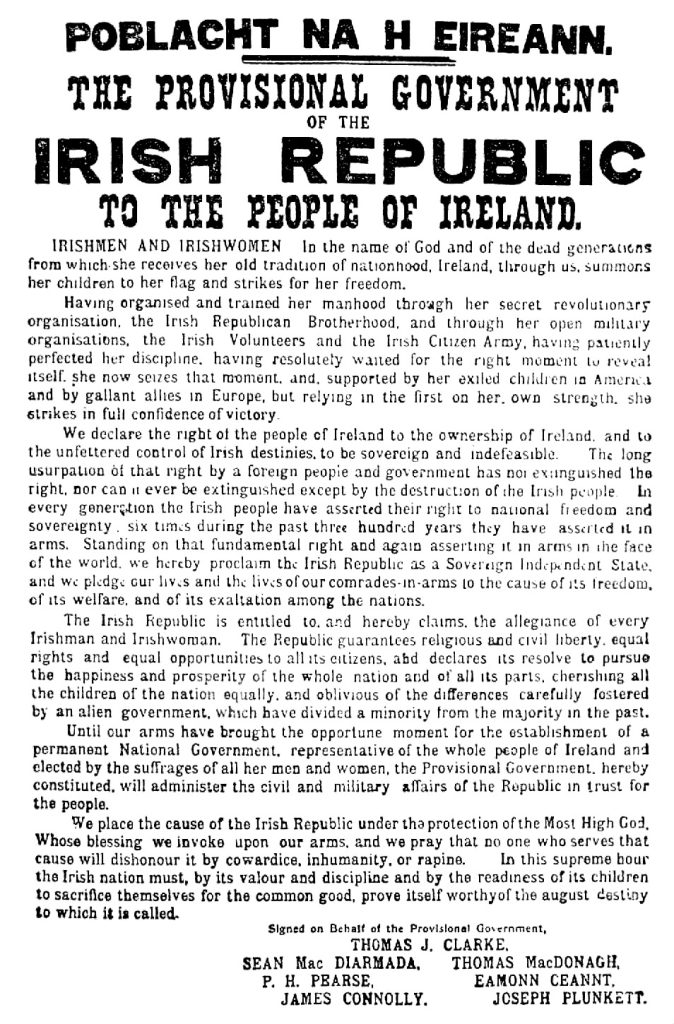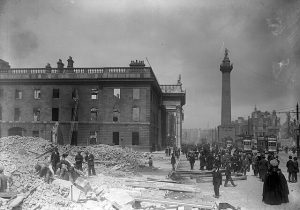
Public Domain via Wikimedia Commons
On Easter Monday 24 April 1916 Irish nationalists along with some 1.600 followers seized government buildings in Dublin seeking the ouster of Britain from Ireland. It was planned by Patrick Pearse, Tom Clarke and others in the Irish Republican Brotherhood and was part of a larger group called Irish Volunteers. The Irish Volunteers had around 16,000 members. There was also the Irish Citizen Army which was comprised of Dublin workers who had been of the failed general strike in 1913. The small Sinn Fein party was also involved as well.
With the outbreak of war in 1914, Roger Casement and John Devoy went to Germany to seek their support for an uprising in November 1914. Casement believed that combined with Irish prisoners of war and aided by German forces, they would be able to secure the capital. The planned Irish Brigades that were to be formed never came to be and Germans did not want to commit troops openly for an Irish rebellion. However, the Germans did agree to ship arms and ammunitions to the Irish Volunteers, which had become difficult to get with wartime restrictions.

Circa May 1916
Author: Keogh Brothers Ltd., photographers
Public Domain via Wikimedia Commons
On 9 April 1915, the SS Libau (a German Navy ship disguised as a Norwegian freighter), arrived in County Kerry delivering 20,000 rifles and one million rounds of ammunition and explosives. Casement was disappointed with the amount supplied and hoped to at least postpone the rising until they got more weapons and ammunition. Meanwhile the Irish Volunteers continued to amass ammunition from whatever sources they could. Though initially planned to be national in scope, the rising ended primarily in Dublin. The British had learned of the uprising and had made several arrests on April 21. Patrick Pearse and Tom Clarke went ahead with their plans and seized the Dublin General Post Office and other points in the Dublin City Center. Pearse read a proclamation announcing the birth of the Irish nation. British troops were sent in to put down the rebellion, which began a week-long battle in the streets between the two. Dublin was paralyzed during this time. British artillery was used against the rebels and forced their capitulation in the end.
All of the leaders of the Easter Rising were court-martialed and executed. The uprising itself was not generally supported by most Irish. However, the executions and arrest of anyone thought to have been involved with the rebellion angered many along with the imposition of martial law turned the leaders into martyrs. Instead of stamping out the rebellion, the British response only fueled the cause for many to want an Irish free state (sounds familiar to those who study the American Revolution).
Aftermath
In 1919, the Irish Republican Army began a guerilla war against the British in Ireland. A cease fire was called in July 1921 and a treaty was signed in 1921. The treaty established the Irish Free State as a self-governing nation of the British commonwealth. However, the treaty allowed for an opt-out provision and the six northern counties decided to stay with the United Kingdom. This was not wholly popular with many in the Irish leadership (and led to internal strife and killings). It was not until Easter Monday in 1949 that the Republic of Ireland was fully declared (except for the northern counties that had opted out).
Sources:
- “Easter Rising | Events, Leaders, Executions, and Facts.” Encyclopedia Britannica, 17 Apr. 2024, britannica.com/event/Easter-Rising.
- History, Easter Rising-1916 Ireland &. Leaders |. “Easter Rising – 1916, Ireland and Leaders | HISTORY.”HISTORY, 25 Jan. 2019, history.com/topics/british-history/easter-rising.
